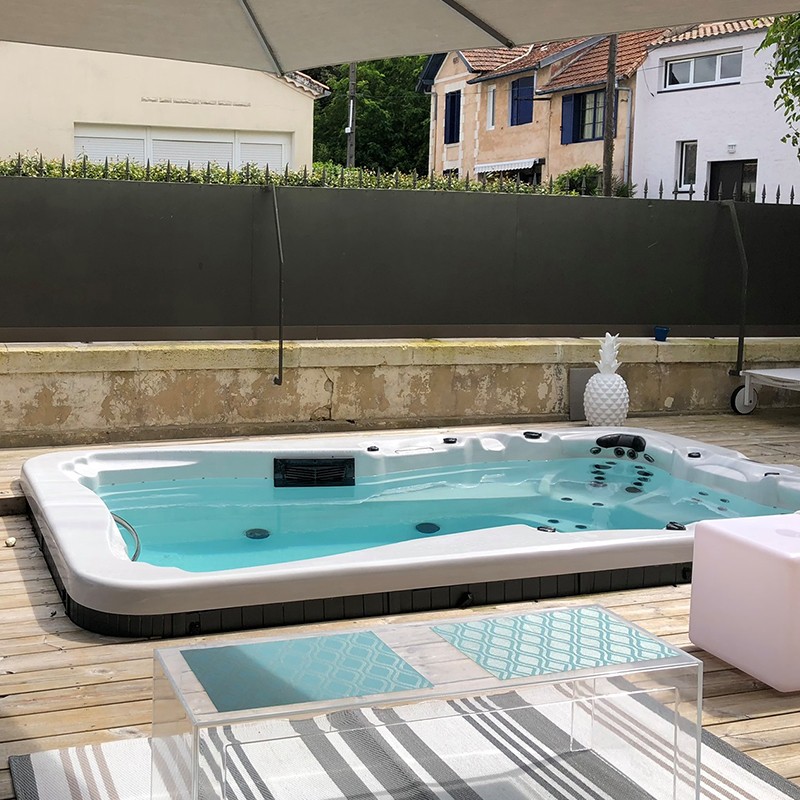
What chemicals are needed for a swim spa?
2024-10-10 15:30Swim spas are becoming a popular choice for homes and fitness facilities because they combine the functions of a swimming pool and a hot tub. However, in order to keep the water clean and safe, using the right chemicals is essential.
This article will take a closer look at the various chemicals needed for a swim spa, their functions, and how to use them to help users better maintain the water quality of the spa.
What is the importance of keeping the water clean?
● Prevent bacterial and algae growth: If the water in a swim spa is not treated regularly, it can easily become a breeding ground for bacteria and algae. This not only affects the water quality, but may also pose a threat to the health of the user.
● Extend the life of the equipment: The correct use of chemicals can prevent mineral precipitation and corrosion in the water, protect the internal equipment and pipes of the spa, and extend its service life.
● Improve the user experience: Clean water quality can improve the user experience, avoid skin irritation, red eyes and other problems, and ensure that every use is comfortable and enjoyable.

What chemicals are needed for a swim spa?
Chemicals needed for swimming spas:
1. Chlorine disinfectant
2. Bromine disinfectant
3. pH adjuster
4. Alkalinity adjuster
5. Hardness adjuster
6. Metal chelator
7. Oxidant
Chlorine disinfectant
● Function: Chlorine is a powerful disinfectant that can effectively kill bacteria and viruses in the water and prevent water quality from deteriorating.
●How to use: Usually added to water in the form of chlorine tablets or chlorine granules, once or more per week depending on the amount of water and frequency of use.
●Notes: Excessive chlorine concentration can cause skin and eye discomfort. The chlorine content in the water should be tested regularly and kept within the appropriate range.
Bromine disinfectant
●Function: Bromine is a relatively mild disinfectant, suitable for users who are allergic to chlorine or sensitive to the smell of chlorine.
●How to use: Bromine tablets or bromine granules can be added directly to the water, or they can be continuously released through a bromine dispenser.
●Notes: The disinfection effect of bromine is more stable under high temperature conditions and is suitable for hot tubs and spas.
pH regulator
●Function: Maintain the acid-base balance of water quality and prevent the water quality from being too acidic or too alkaline, thereby protecting the equipment and improving user comfort.
●How to use: According to the water quality test results, use an acidic regulator (such as hydrochloric acid) or an alkaline regulator (such as sodium carbonate) to adjust the pH value.
●Notes: The pH value should be kept between 7.2 and 7.8. Too high or too low pH values will affect the effect of the disinfectant and the service life of the equipment.
Alkalinity regulator
●Function: Keep the total alkalinity of water stable, prevent drastic fluctuations in pH, and ensure that disinfectants work effectively.
●How to use: Add sodium bicarbonate or other alkalinity regulators according to the water quality test results.
●Notes: The total alkalinity should be maintained between 80 and 120 ppm (parts per million).
Hardness regulator
●Function: Adjust the hardness of water to prevent scale formation and equipment corrosion.
●How to use: Add calcium hardness increaser or use a water softener according to the water quality test results.
●Notes: The hardness should be maintained between 150 and 400 ppm. Too high or too low will affect the use and maintenance of the spa.
Metal chelator
●Function: Remove excess metal ions such as iron, copper and manganese from water to prevent water discoloration and metal deposition.
●How to use: Add during initial water filling or regular maintenance, and adjust the dosage according to water quality.
●Notes: Metal chelators should be used in combination with other chemicals to ensure the best effect.
Oxidant
●Function: Remove organic matter and impurities in the water, enhance the effect of disinfectants, and keep the water clean.
●How to use: Use oxidants (such as persulfate or potassium monopersulfate) for shock treatment regularly.
●Note: After shock treatment, you should wait for a certain period of time before using the spa to ensure that the chemicals are fully reacted.

What are the specific steps for using chemicals?
Test water quality
Use professional water quality testing tools or test strips to regularly test the pH value, chlorine or bromine content, total alkalinity and hardness in the water to understand the water quality.
Add chemicals
According to the test results, add the corresponding chemicals as needed. Generally, chlorine or bromine disinfectants should be added regularly, while pH adjusters, alkalinity adjusters and hardness adjusters are adjusted according to changes in water quality.
Stir evenly
After adding chemicals, turn on the circulation system of the spa to ensure that the chemicals are fully mixed in the water to achieve an even distribution effect.
Repeat testing
After adding chemicals, test the water quality again after a period of time to ensure that all indicators are within the appropriate range and make adjustments if necessary.

Precautions and safe use guidelines
Proper storage of chemicals
Chemicals should be stored in a cool, dry, well-ventilated place away from direct sunlight and high temperature environments. Different types of chemicals should be stored separately to prevent mixing and reaction.
Safe operation
When adding chemicals, wear protective gloves and goggles to avoid direct contact with skin and eyes. During use, pay attention to follow the instructions and avoid overdose.
Child and pet safety
Chemicals should be placed out of reach of children and pets to avoid accidental ingestion or misuse. Ensure the safety of children and pets when using a spa.
Emergency treatment
If chemicals splash into the eyes or come into contact with the skin, rinse immediately with plenty of water and seek medical attention as soon as possible. If chemicals are ingested by mistake, seek medical attention immediately and inform the medical staff of the specific name and composition of the chemical ingested.
